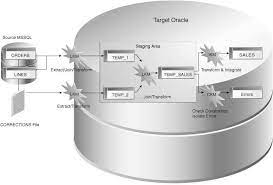Optimizing performance and scalability in Oracle Data Integrator (ODI) is essential to ensure efficient execution of data integration processes and handle increasing data volumes. Here are some techniques to optimize ODI performance and scalability:
- Data and Metadata Design:
- Design data models, mappings, and transformations efficiently to minimize data processing overhead.
- Analyze the data sources and target systems to understand data structures, indexing, and partitioning strategies.
- Utilize appropriate data integration techniques such as pushdown optimization, bulk loading, or incremental updates.
- Optimize mappings by reducing unnecessary transformations, eliminating redundant joins, and leveraging database-specific features.
- Parallel Execution:
- ODI supports parallel execution of interfaces, packages, and scenarios to improve performance.
- Configure parallel execution settings in ODI to allow multiple components to run concurrently.
- Utilize parallelism at various levels, such as mapping levels or target table levels.
- Consider the available system resources, such as CPU cores or database parallelism capabilities, when determining the optimal degree of parallelism.
- Load Balancing and Distribution:
- Distribute workloads across multiple ODI agents to achieve load balancing and scalability.
- Configure agent groups and assign agents to handle specific tasks or datasets.
- Utilize load balancing algorithms to evenly distribute workloads among the available agents.
- Consider network bandwidth and system resource capacity when distributing workloads.
- Caching and Reusing:
- ODI provides caching mechanisms to improve performance by reducing redundant data access.
- Utilize ODI’s caching features, such as reusable mappings or lookup caches, to avoid unnecessary data retrieval.
- Cache frequently accessed data or lookup tables to minimize database round trips.
- Leverage ODI’s knowledge module options to enable caching where appropriate.
- Indexing and Partitioning:
- Optimize database performance by properly indexing and partitioning tables used in ODI.
- Analyze query patterns and access patterns to identify key columns for indexing.
- Implement appropriate partitioning strategies to improve data access and processing.
- Regularly analyze and maintain indexes and partitions to ensure optimal performance.
- System Configuration:
- Ensure that the ODI infrastructure is configured optimally for performance.
- Allocate appropriate system resources, such as CPU, memory, and disk space, to the ODI environment.
- Tune database settings and parameters to align with ODI’s requirements and workload.
- Regularly monitor system performance and adjust configurations as needed.
- Performance Monitoring and Tuning:
- Continuously monitor performance metrics and identify areas for improvement.
- Utilize ODI’s performance monitoring tools, such as the Load Plan Monitor or the Load Plan Visualizer, to analyze execution statistics.
- Identify bottlenecks, long-running queries, or resource-intensive operations.
- Fine-tune mappings, procedures, or scenarios based on performance insights and recommendations.
- Hardware and Infrastructure Scaling:
- Plan for scalability by considering hardware and infrastructure requirements.
- Evaluate the need for additional servers, storage, or network resources as data volumes and processing demands increase.
- Design a scalable architecture that allows for horizontal scaling, such as adding more agents or load balancers, as needed.
By implementing these optimization techniques, monitoring performance metrics, and continuously tuning the system, you can achieve better performance, scalability, and efficiency in your ODI environment. It is important to conduct thorough testing and performance benchmarking to validate the impact of optimizations before deploying them to a production environment.
SHARE
